Business Feasibility Analysis of Starbucks Coffee in New Market
VerifiedAdded on 2022/11/24
|26
|3595
|79
Report
AI Summary
This report presents a business feasibility analysis of Starbucks, examining its potential for expansion. The analysis begins with an introduction to Starbucks' business, market presence, and operational segments. It then details the data collection methods used, including questionnaires and sampling techniques, along with primary and secondary sources. The research methodology, including the survey method, sampling frame, and questionnaire design, is clearly outlined. Data summarization and descriptive analysis are performed to assess consumer preferences regarding taste, variety, quality, price, service, and cleanliness. The report interprets the data, providing insights for decision-making, and concludes with recommendations for Starbucks to improve its offerings, particularly focusing on price and quality, to succeed in a new market. The analysis emphasizes the importance of understanding consumer attitudes and adapting strategies for market entry.
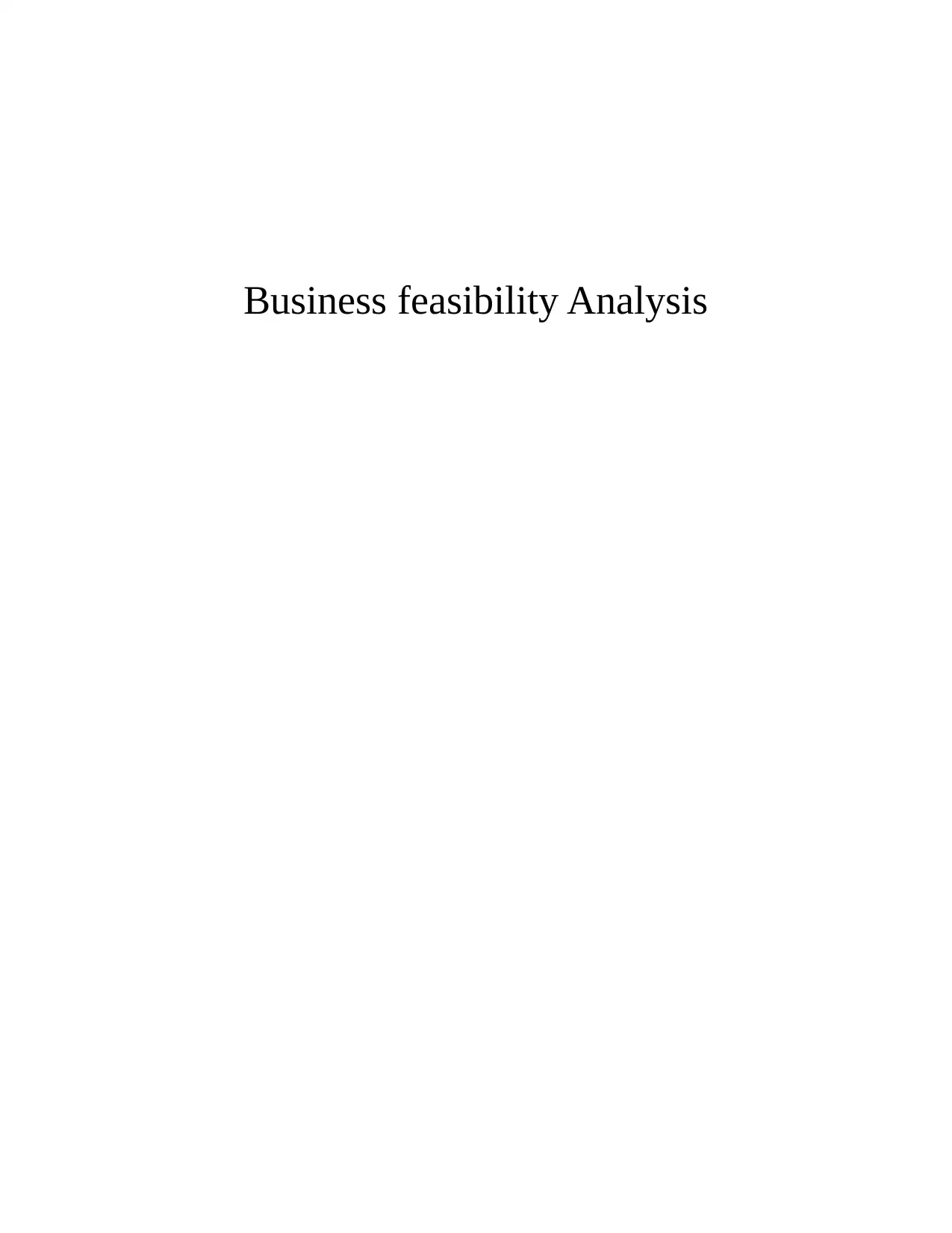
Business feasibility Analysis
Paraphrase This Document
Need a fresh take? Get an instant paraphrase of this document with our AI Paraphraser
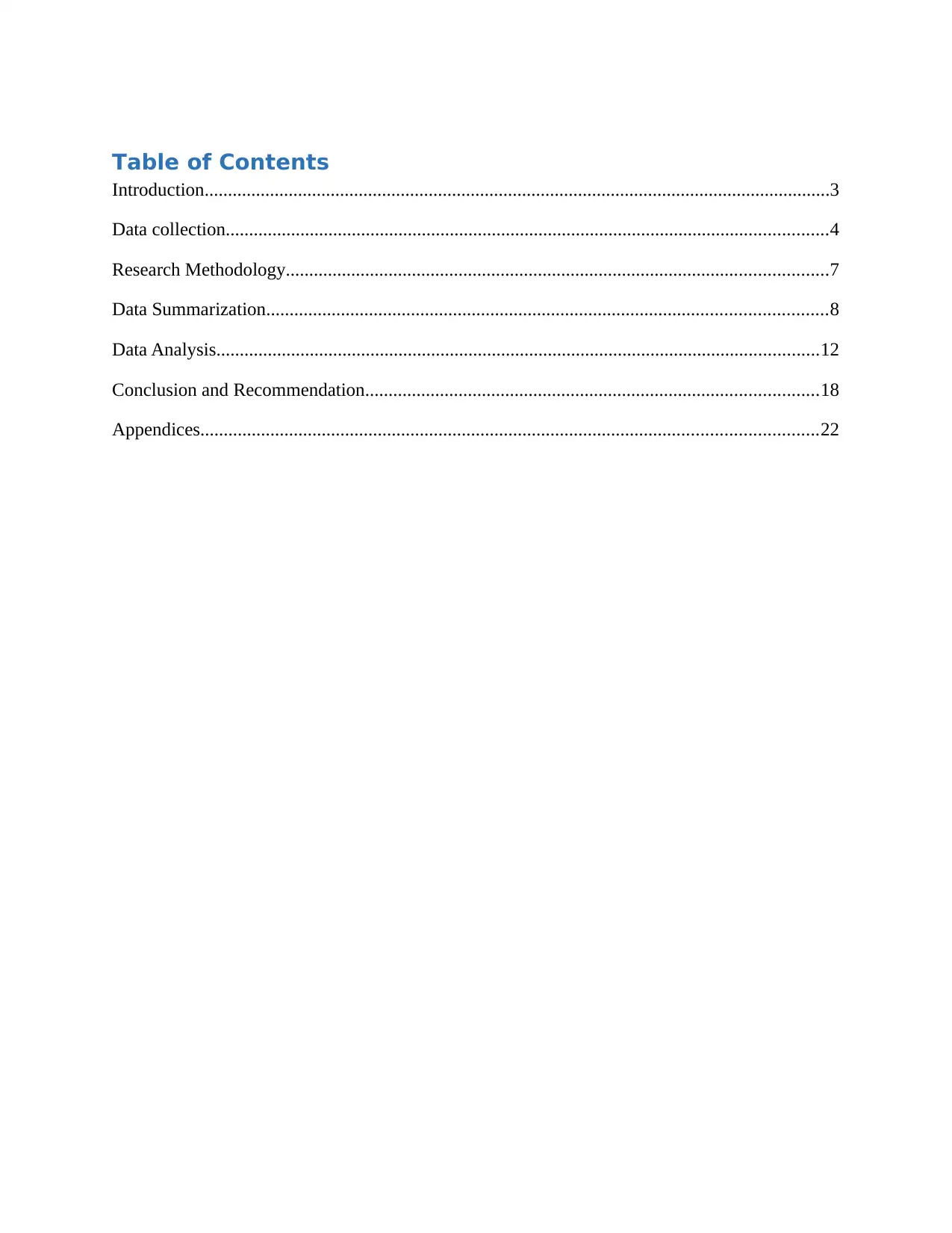
Table of Contents
Introduction......................................................................................................................................3
Data collection.................................................................................................................................4
Research Methodology....................................................................................................................7
Data Summarization........................................................................................................................8
Data Analysis.................................................................................................................................12
Conclusion and Recommendation.................................................................................................18
Appendices....................................................................................................................................22
Introduction......................................................................................................................................3
Data collection.................................................................................................................................4
Research Methodology....................................................................................................................7
Data Summarization........................................................................................................................8
Data Analysis.................................................................................................................................12
Conclusion and Recommendation.................................................................................................18
Appendices....................................................................................................................................22
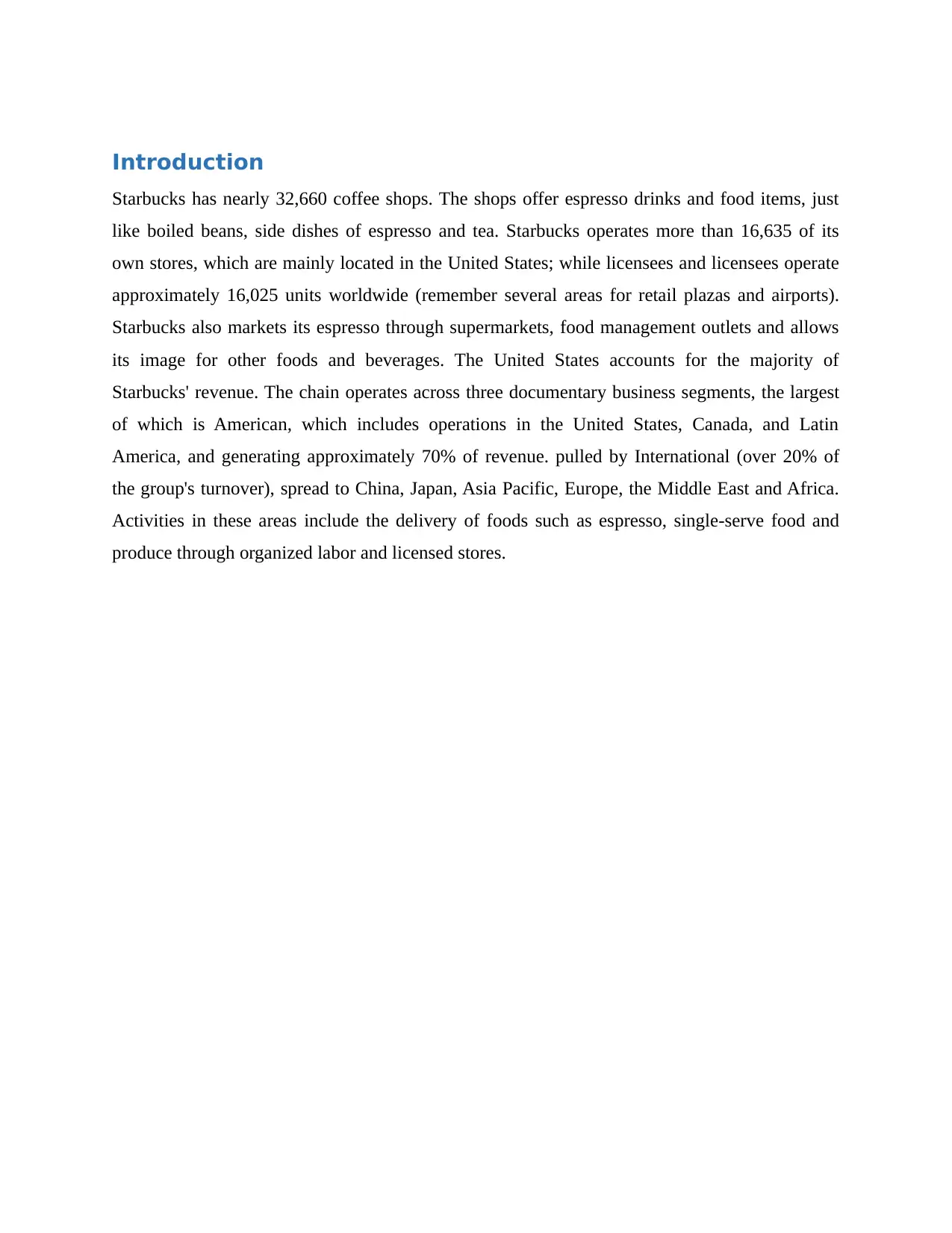
Introduction
Starbucks has nearly 32,660 coffee shops. The shops offer espresso drinks and food items, just
like boiled beans, side dishes of espresso and tea. Starbucks operates more than 16,635 of its
own stores, which are mainly located in the United States; while licensees and licensees operate
approximately 16,025 units worldwide (remember several areas for retail plazas and airports).
Starbucks also markets its espresso through supermarkets, food management outlets and allows
its image for other foods and beverages. The United States accounts for the majority of
Starbucks' revenue. The chain operates across three documentary business segments, the largest
of which is American, which includes operations in the United States, Canada, and Latin
America, and generating approximately 70% of revenue. pulled by International (over 20% of
the group's turnover), spread to China, Japan, Asia Pacific, Europe, the Middle East and Africa.
Activities in these areas include the delivery of foods such as espresso, single-serve food and
produce through organized labor and licensed stores.
Starbucks has nearly 32,660 coffee shops. The shops offer espresso drinks and food items, just
like boiled beans, side dishes of espresso and tea. Starbucks operates more than 16,635 of its
own stores, which are mainly located in the United States; while licensees and licensees operate
approximately 16,025 units worldwide (remember several areas for retail plazas and airports).
Starbucks also markets its espresso through supermarkets, food management outlets and allows
its image for other foods and beverages. The United States accounts for the majority of
Starbucks' revenue. The chain operates across three documentary business segments, the largest
of which is American, which includes operations in the United States, Canada, and Latin
America, and generating approximately 70% of revenue. pulled by International (over 20% of
the group's turnover), spread to China, Japan, Asia Pacific, Europe, the Middle East and Africa.
Activities in these areas include the delivery of foods such as espresso, single-serve food and
produce through organized labor and licensed stores.
⊘ This is a preview!⊘
Do you want full access?
Subscribe today to unlock all pages.

Trusted by 1+ million students worldwide
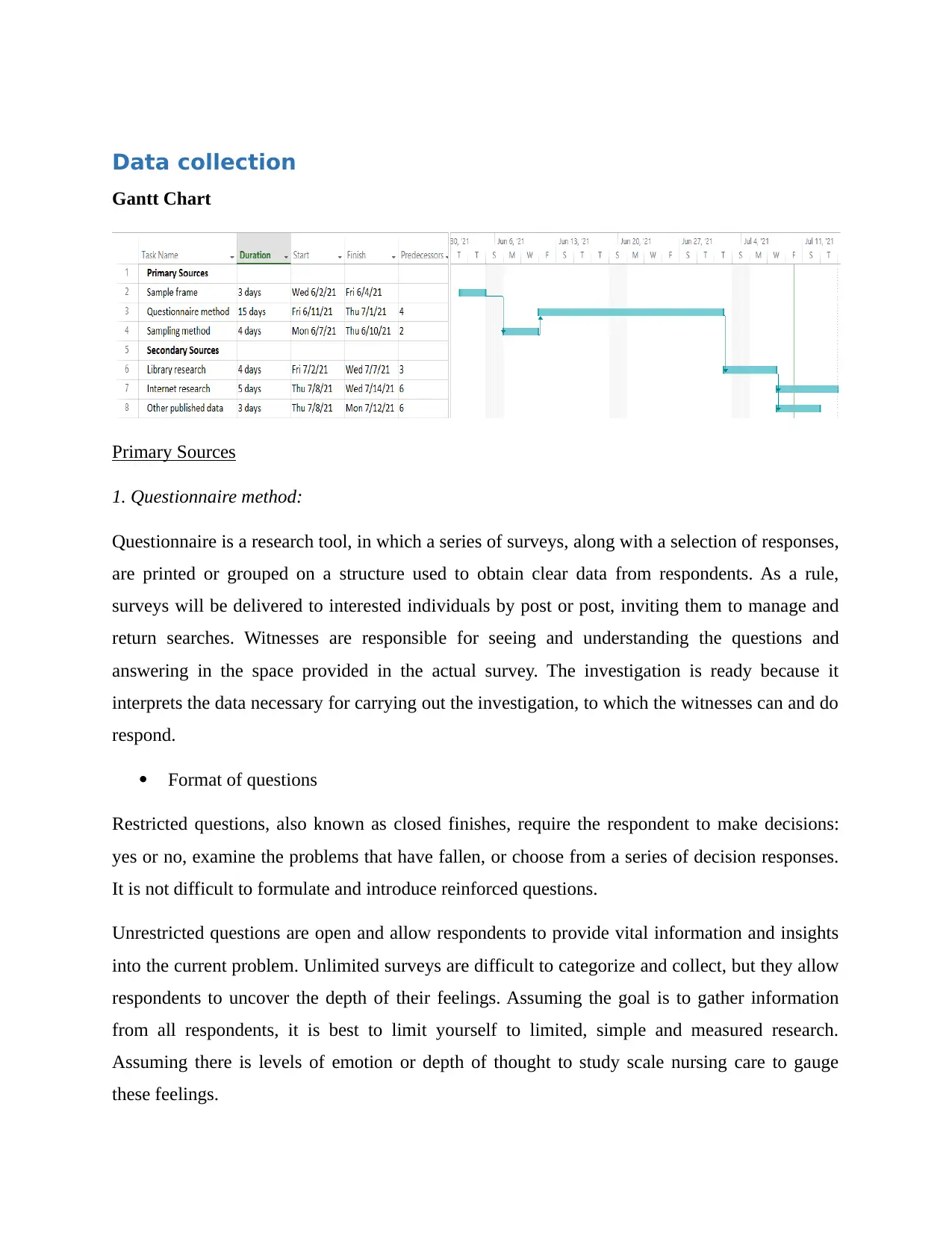
Data collection
Gantt Chart
Primary Sources
1. Questionnaire method:
Questionnaire is a research tool, in which a series of surveys, along with a selection of responses,
are printed or grouped on a structure used to obtain clear data from respondents. As a rule,
surveys will be delivered to interested individuals by post or post, inviting them to manage and
return searches. Witnesses are responsible for seeing and understanding the questions and
answering in the space provided in the actual survey. The investigation is ready because it
interprets the data necessary for carrying out the investigation, to which the witnesses can and do
respond.
Format of questions
Restricted questions, also known as closed finishes, require the respondent to make decisions:
yes or no, examine the problems that have fallen, or choose from a series of decision responses.
It is not difficult to formulate and introduce reinforced questions.
Unrestricted questions are open and allow respondents to provide vital information and insights
into the current problem. Unlimited surveys are difficult to categorize and collect, but they allow
respondents to uncover the depth of their feelings. Assuming the goal is to gather information
from all respondents, it is best to limit yourself to limited, simple and measured research.
Assuming there is levels of emotion or depth of thought to study scale nursing care to gauge
these feelings.
Gantt Chart
Primary Sources
1. Questionnaire method:
Questionnaire is a research tool, in which a series of surveys, along with a selection of responses,
are printed or grouped on a structure used to obtain clear data from respondents. As a rule,
surveys will be delivered to interested individuals by post or post, inviting them to manage and
return searches. Witnesses are responsible for seeing and understanding the questions and
answering in the space provided in the actual survey. The investigation is ready because it
interprets the data necessary for carrying out the investigation, to which the witnesses can and do
respond.
Format of questions
Restricted questions, also known as closed finishes, require the respondent to make decisions:
yes or no, examine the problems that have fallen, or choose from a series of decision responses.
It is not difficult to formulate and introduce reinforced questions.
Unrestricted questions are open and allow respondents to provide vital information and insights
into the current problem. Unlimited surveys are difficult to categorize and collect, but they allow
respondents to uncover the depth of their feelings. Assuming the goal is to gather information
from all respondents, it is best to limit yourself to limited, simple and measured research.
Assuming there is levels of emotion or depth of thought to study scale nursing care to gauge
these feelings.
Paraphrase This Document
Need a fresh take? Get an instant paraphrase of this document with our AI Paraphraser
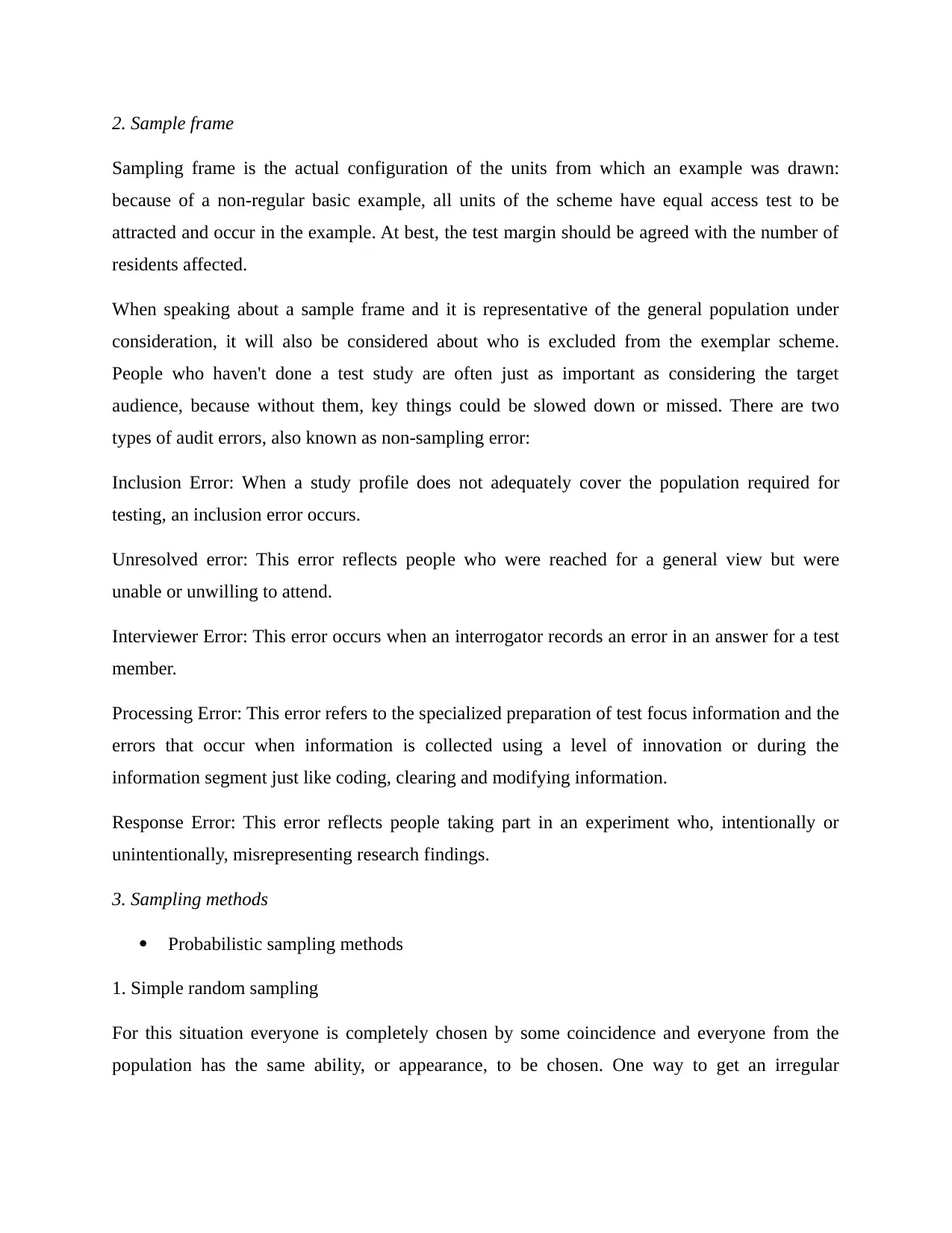
2. Sample frame
Sampling frame is the actual configuration of the units from which an example was drawn:
because of a non-regular basic example, all units of the scheme have equal access test to be
attracted and occur in the example. At best, the test margin should be agreed with the number of
residents affected.
When speaking about a sample frame and it is representative of the general population under
consideration, it will also be considered about who is excluded from the exemplar scheme.
People who haven't done a test study are often just as important as considering the target
audience, because without them, key things could be slowed down or missed. There are two
types of audit errors, also known as non-sampling error:
Inclusion Error: When a study profile does not adequately cover the population required for
testing, an inclusion error occurs.
Unresolved error: This error reflects people who were reached for a general view but were
unable or unwilling to attend.
Interviewer Error: This error occurs when an interrogator records an error in an answer for a test
member.
Processing Error: This error refers to the specialized preparation of test focus information and the
errors that occur when information is collected using a level of innovation or during the
information segment just like coding, clearing and modifying information.
Response Error: This error reflects people taking part in an experiment who, intentionally or
unintentionally, misrepresenting research findings.
3. Sampling methods
Probabilistic sampling methods
1. Simple random sampling
For this situation everyone is completely chosen by some coincidence and everyone from the
population has the same ability, or appearance, to be chosen. One way to get an irregular
Sampling frame is the actual configuration of the units from which an example was drawn:
because of a non-regular basic example, all units of the scheme have equal access test to be
attracted and occur in the example. At best, the test margin should be agreed with the number of
residents affected.
When speaking about a sample frame and it is representative of the general population under
consideration, it will also be considered about who is excluded from the exemplar scheme.
People who haven't done a test study are often just as important as considering the target
audience, because without them, key things could be slowed down or missed. There are two
types of audit errors, also known as non-sampling error:
Inclusion Error: When a study profile does not adequately cover the population required for
testing, an inclusion error occurs.
Unresolved error: This error reflects people who were reached for a general view but were
unable or unwilling to attend.
Interviewer Error: This error occurs when an interrogator records an error in an answer for a test
member.
Processing Error: This error refers to the specialized preparation of test focus information and the
errors that occur when information is collected using a level of innovation or during the
information segment just like coding, clearing and modifying information.
Response Error: This error reflects people taking part in an experiment who, intentionally or
unintentionally, misrepresenting research findings.
3. Sampling methods
Probabilistic sampling methods
1. Simple random sampling
For this situation everyone is completely chosen by some coincidence and everyone from the
population has the same ability, or appearance, to be chosen. One way to get an irregular
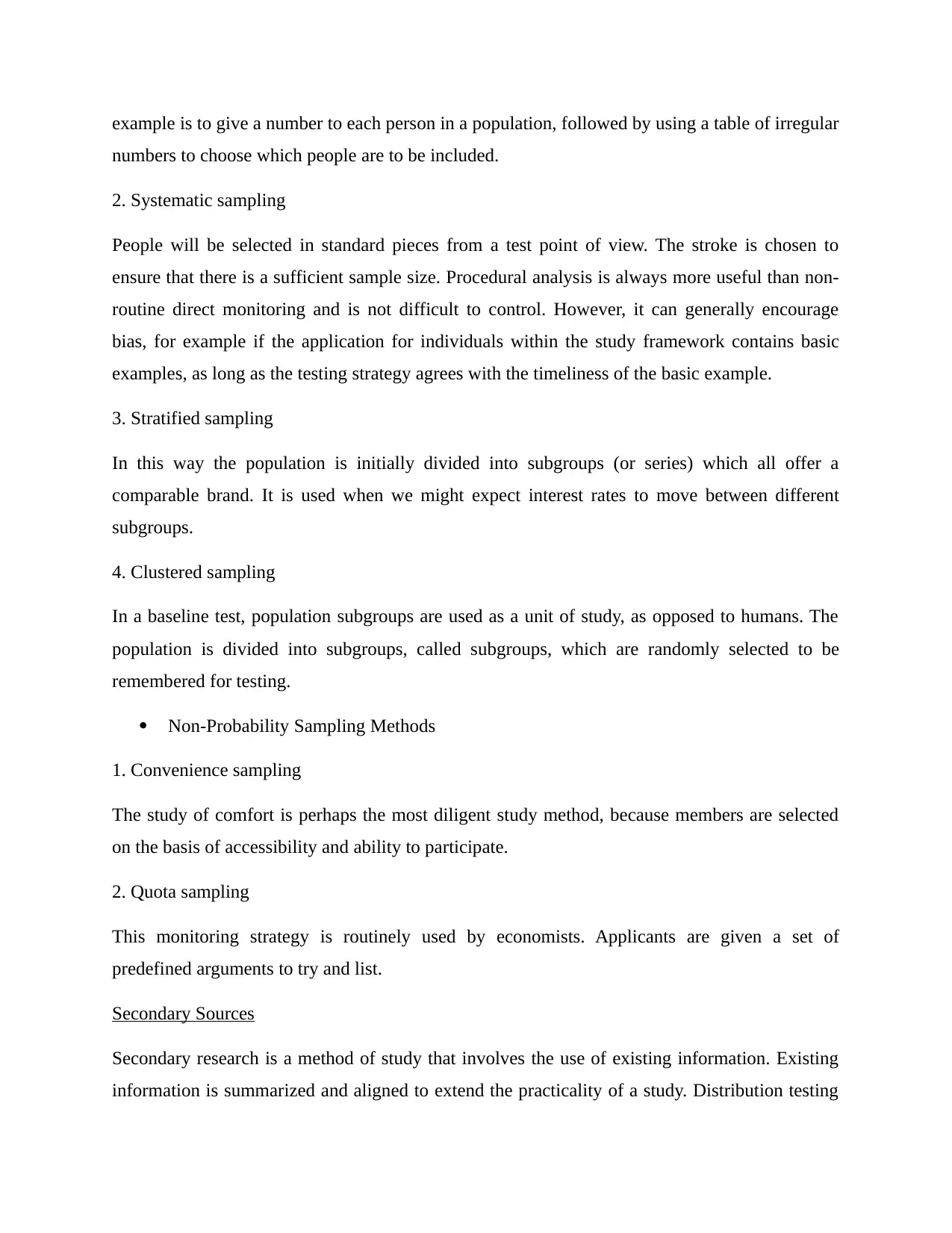
example is to give a number to each person in a population, followed by using a table of irregular
numbers to choose which people are to be included.
2. Systematic sampling
People will be selected in standard pieces from a test point of view. The stroke is chosen to
ensure that there is a sufficient sample size. Procedural analysis is always more useful than non-
routine direct monitoring and is not difficult to control. However, it can generally encourage
bias, for example if the application for individuals within the study framework contains basic
examples, as long as the testing strategy agrees with the timeliness of the basic example.
3. Stratified sampling
In this way the population is initially divided into subgroups (or series) which all offer a
comparable brand. It is used when we might expect interest rates to move between different
subgroups.
4. Clustered sampling
In a baseline test, population subgroups are used as a unit of study, as opposed to humans. The
population is divided into subgroups, called subgroups, which are randomly selected to be
remembered for testing.
Non-Probability Sampling Methods
1. Convenience sampling
The study of comfort is perhaps the most diligent study method, because members are selected
on the basis of accessibility and ability to participate.
2. Quota sampling
This monitoring strategy is routinely used by economists. Applicants are given a set of
predefined arguments to try and list.
Secondary Sources
Secondary research is a method of study that involves the use of existing information. Existing
information is summarized and aligned to extend the practicality of a study. Distribution testing
numbers to choose which people are to be included.
2. Systematic sampling
People will be selected in standard pieces from a test point of view. The stroke is chosen to
ensure that there is a sufficient sample size. Procedural analysis is always more useful than non-
routine direct monitoring and is not difficult to control. However, it can generally encourage
bias, for example if the application for individuals within the study framework contains basic
examples, as long as the testing strategy agrees with the timeliness of the basic example.
3. Stratified sampling
In this way the population is initially divided into subgroups (or series) which all offer a
comparable brand. It is used when we might expect interest rates to move between different
subgroups.
4. Clustered sampling
In a baseline test, population subgroups are used as a unit of study, as opposed to humans. The
population is divided into subgroups, called subgroups, which are randomly selected to be
remembered for testing.
Non-Probability Sampling Methods
1. Convenience sampling
The study of comfort is perhaps the most diligent study method, because members are selected
on the basis of accessibility and ability to participate.
2. Quota sampling
This monitoring strategy is routinely used by economists. Applicants are given a set of
predefined arguments to try and list.
Secondary Sources
Secondary research is a method of study that involves the use of existing information. Existing
information is summarized and aligned to extend the practicality of a study. Distribution testing
⊘ This is a preview!⊘
Do you want full access?
Subscribe today to unlock all pages.

Trusted by 1+ million students worldwide
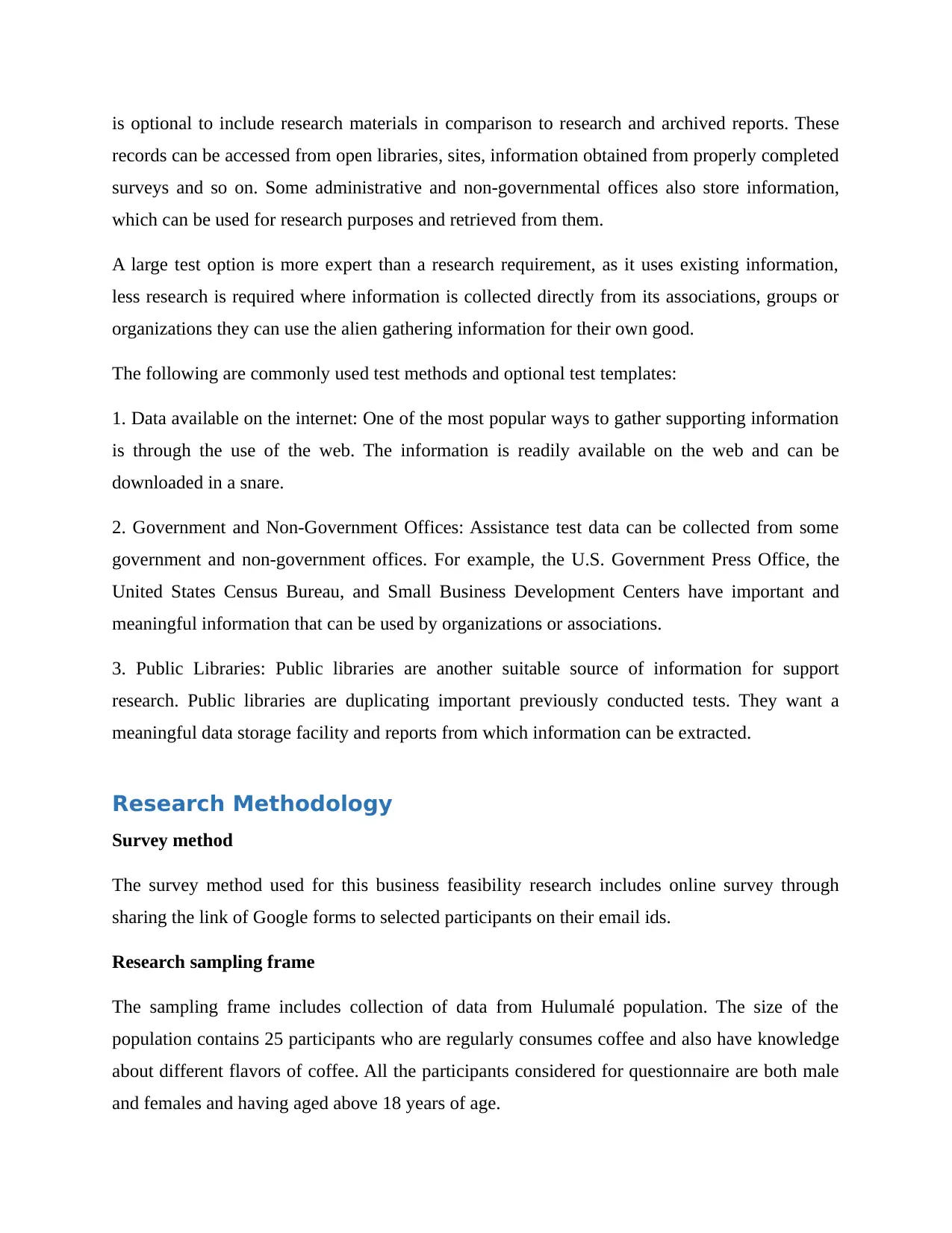
is optional to include research materials in comparison to research and archived reports. These
records can be accessed from open libraries, sites, information obtained from properly completed
surveys and so on. Some administrative and non-governmental offices also store information,
which can be used for research purposes and retrieved from them.
A large test option is more expert than a research requirement, as it uses existing information,
less research is required where information is collected directly from its associations, groups or
organizations they can use the alien gathering information for their own good.
The following are commonly used test methods and optional test templates:
1. Data available on the internet: One of the most popular ways to gather supporting information
is through the use of the web. The information is readily available on the web and can be
downloaded in a snare.
2. Government and Non-Government Offices: Assistance test data can be collected from some
government and non-government offices. For example, the U.S. Government Press Office, the
United States Census Bureau, and Small Business Development Centers have important and
meaningful information that can be used by organizations or associations.
3. Public Libraries: Public libraries are another suitable source of information for support
research. Public libraries are duplicating important previously conducted tests. They want a
meaningful data storage facility and reports from which information can be extracted.
Research Methodology
Survey method
The survey method used for this business feasibility research includes online survey through
sharing the link of Google forms to selected participants on their email ids.
Research sampling frame
The sampling frame includes collection of data from Hulumalé population. The size of the
population contains 25 participants who are regularly consumes coffee and also have knowledge
about different flavors of coffee. All the participants considered for questionnaire are both male
and females and having aged above 18 years of age.
records can be accessed from open libraries, sites, information obtained from properly completed
surveys and so on. Some administrative and non-governmental offices also store information,
which can be used for research purposes and retrieved from them.
A large test option is more expert than a research requirement, as it uses existing information,
less research is required where information is collected directly from its associations, groups or
organizations they can use the alien gathering information for their own good.
The following are commonly used test methods and optional test templates:
1. Data available on the internet: One of the most popular ways to gather supporting information
is through the use of the web. The information is readily available on the web and can be
downloaded in a snare.
2. Government and Non-Government Offices: Assistance test data can be collected from some
government and non-government offices. For example, the U.S. Government Press Office, the
United States Census Bureau, and Small Business Development Centers have important and
meaningful information that can be used by organizations or associations.
3. Public Libraries: Public libraries are another suitable source of information for support
research. Public libraries are duplicating important previously conducted tests. They want a
meaningful data storage facility and reports from which information can be extracted.
Research Methodology
Survey method
The survey method used for this business feasibility research includes online survey through
sharing the link of Google forms to selected participants on their email ids.
Research sampling frame
The sampling frame includes collection of data from Hulumalé population. The size of the
population contains 25 participants who are regularly consumes coffee and also have knowledge
about different flavors of coffee. All the participants considered for questionnaire are both male
and females and having aged above 18 years of age.
Paraphrase This Document
Need a fresh take? Get an instant paraphrase of this document with our AI Paraphraser
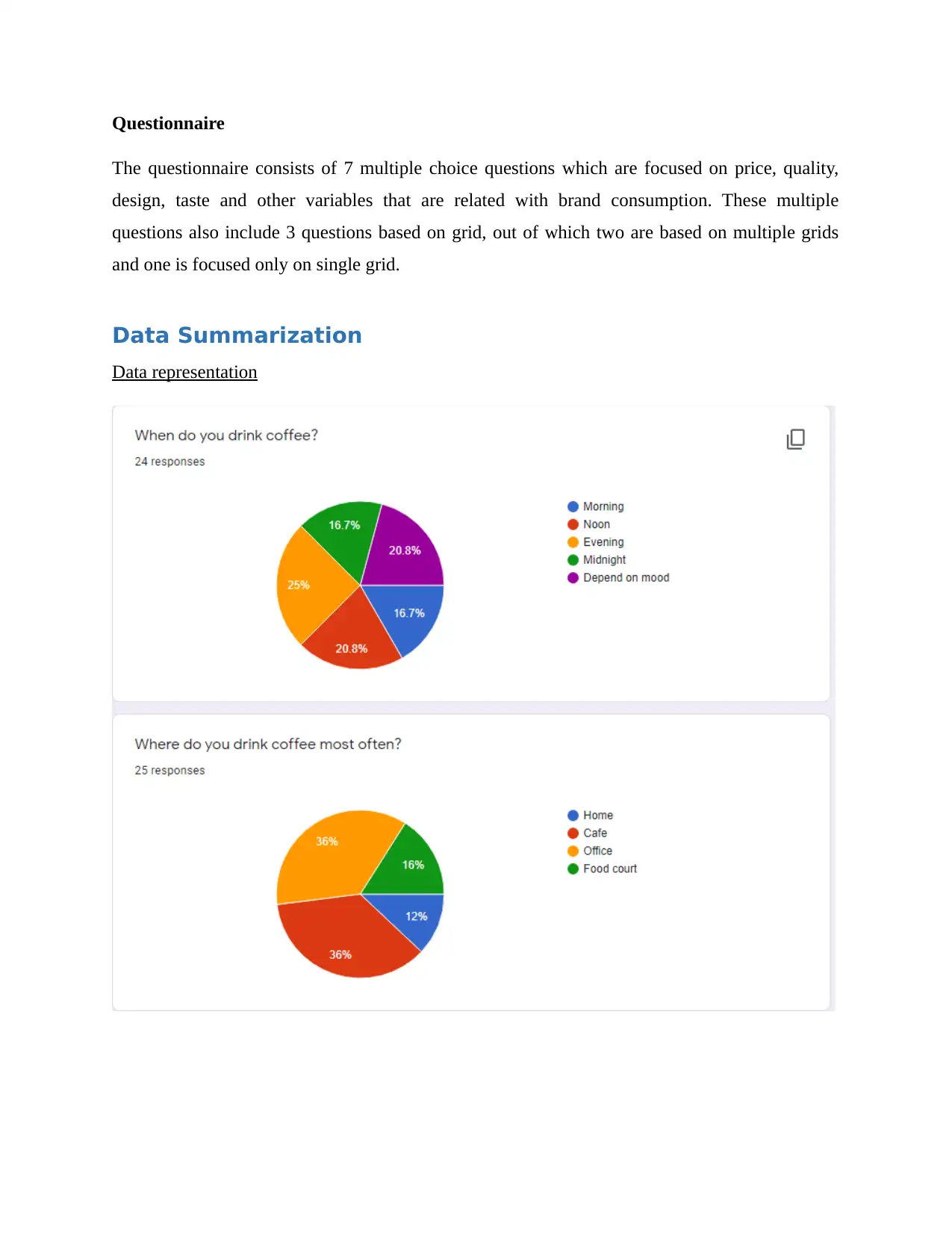
Questionnaire
The questionnaire consists of 7 multiple choice questions which are focused on price, quality,
design, taste and other variables that are related with brand consumption. These multiple
questions also include 3 questions based on grid, out of which two are based on multiple grids
and one is focused only on single grid.
Data Summarization
Data representation
The questionnaire consists of 7 multiple choice questions which are focused on price, quality,
design, taste and other variables that are related with brand consumption. These multiple
questions also include 3 questions based on grid, out of which two are based on multiple grids
and one is focused only on single grid.
Data Summarization
Data representation
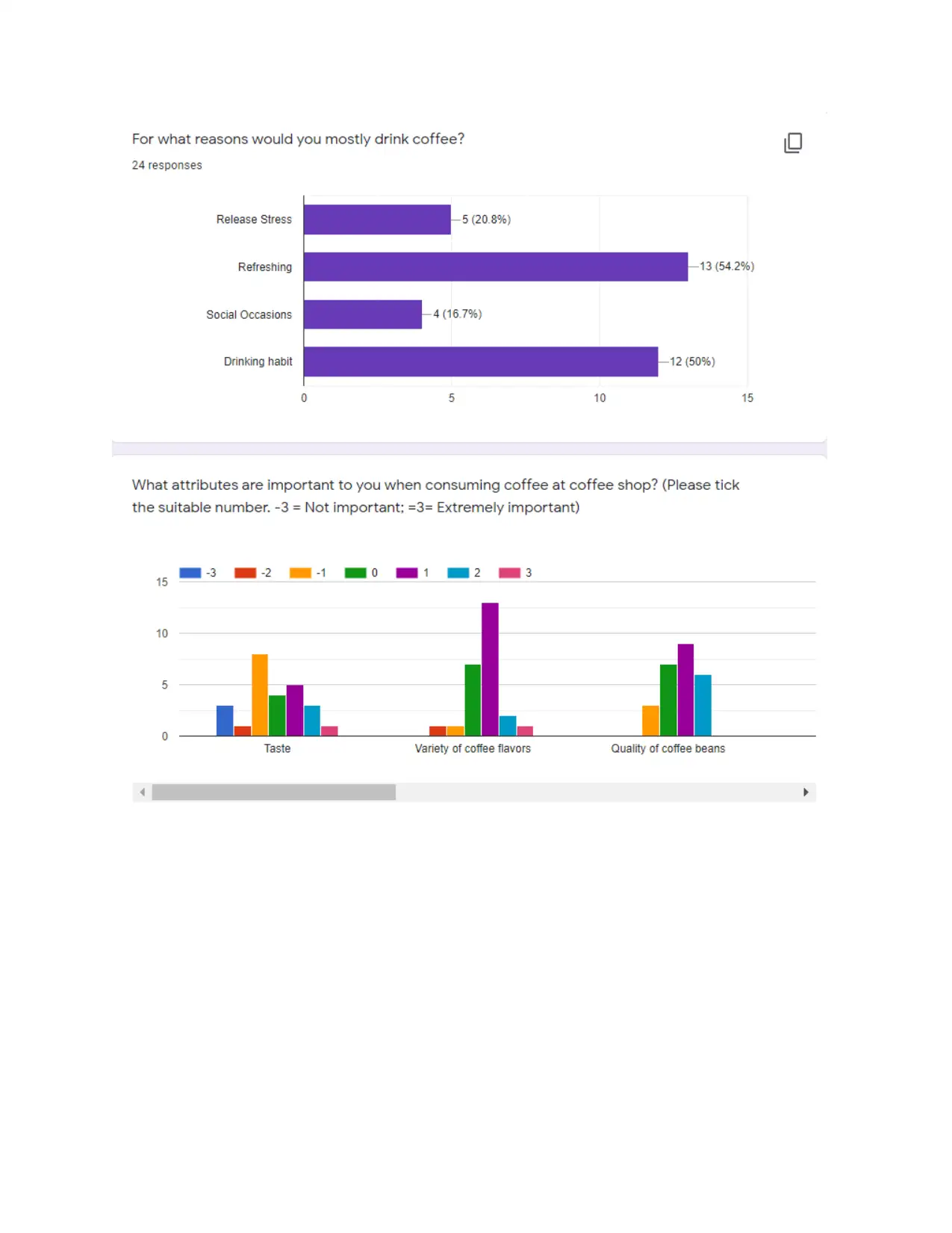
⊘ This is a preview!⊘
Do you want full access?
Subscribe today to unlock all pages.

Trusted by 1+ million students worldwide
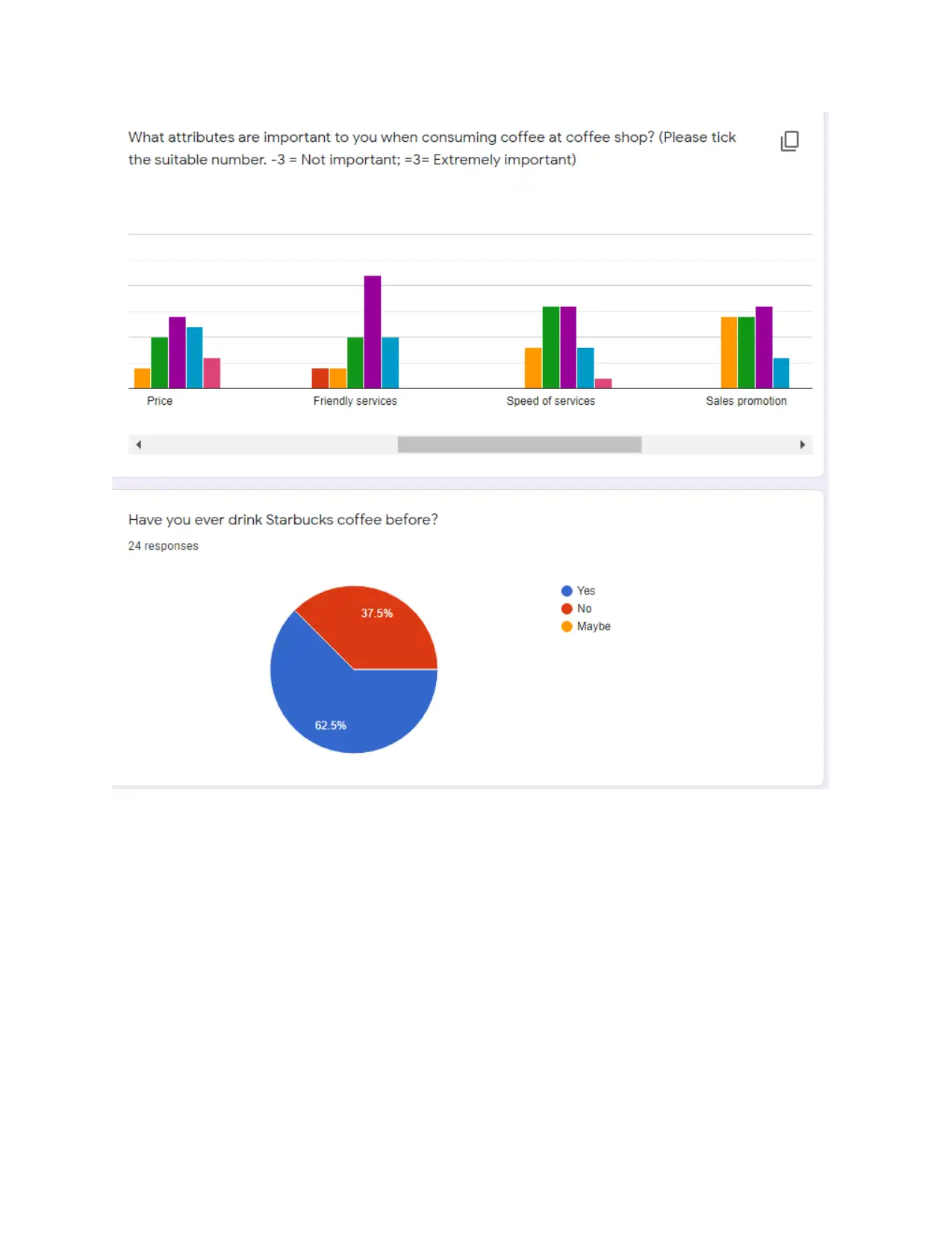
Paraphrase This Document
Need a fresh take? Get an instant paraphrase of this document with our AI Paraphraser
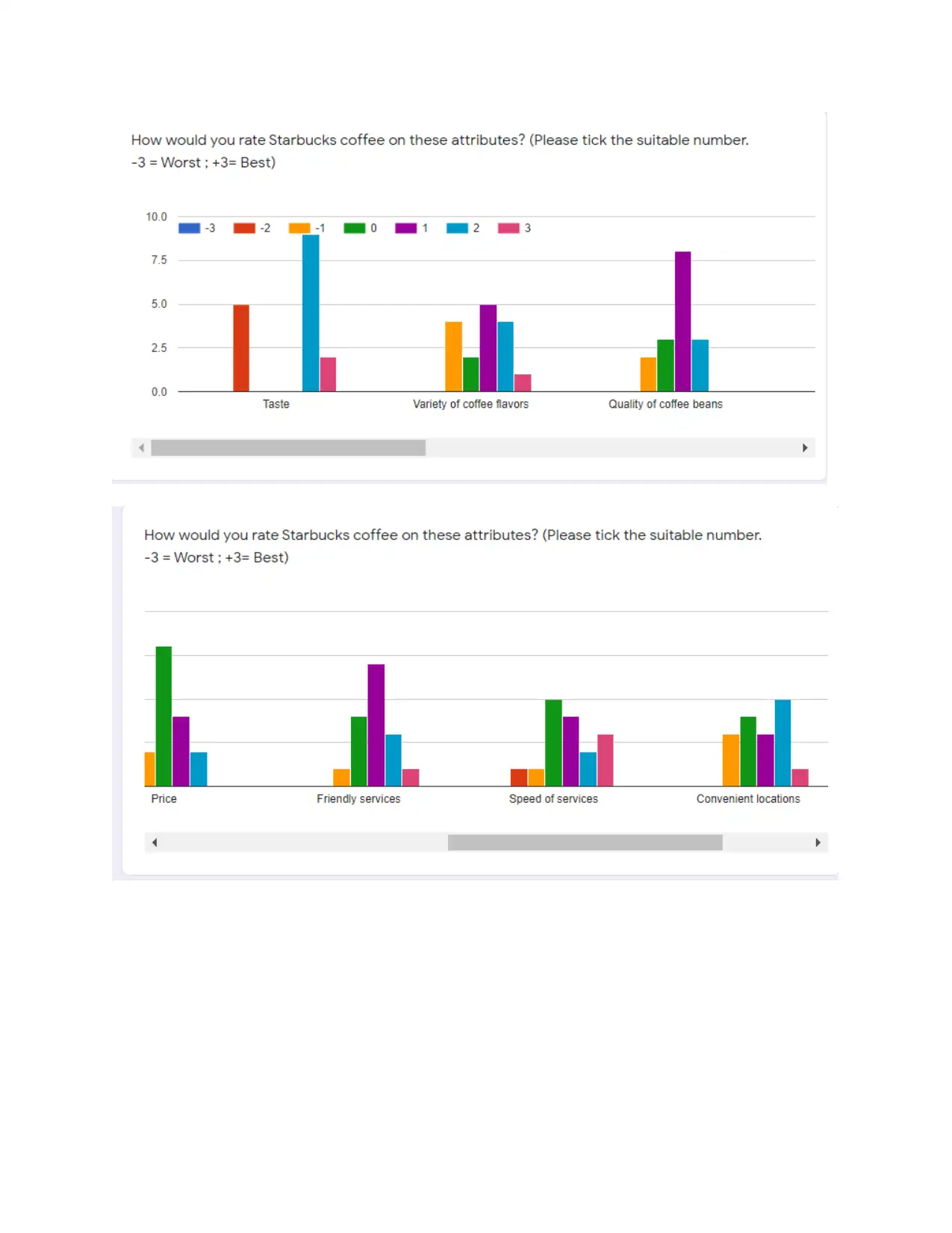
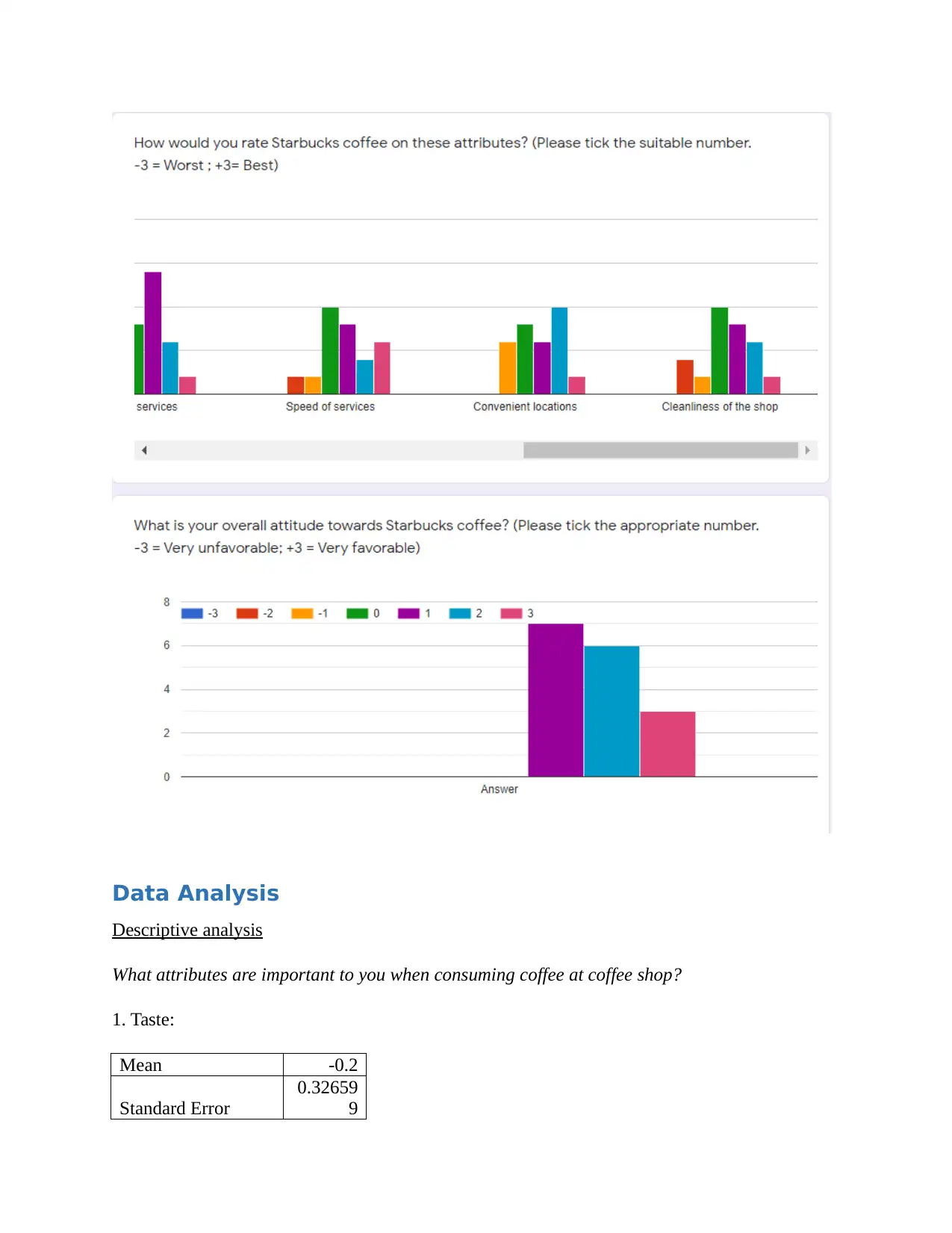
Data Analysis
Descriptive analysis
What attributes are important to you when consuming coffee at coffee shop?
1. Taste:
Mean -0.2
Standard Error
0.32659
9
Descriptive analysis
What attributes are important to you when consuming coffee at coffee shop?
1. Taste:
Mean -0.2
Standard Error
0.32659
9
⊘ This is a preview!⊘
Do you want full access?
Subscribe today to unlock all pages.

Trusted by 1+ million students worldwide
1 out of 26
Your All-in-One AI-Powered Toolkit for Academic Success.
+13062052269
info@desklib.com
Available 24*7 on WhatsApp / Email
![[object Object]](/_next/static/media/star-bottom.7253800d.svg)
Unlock your academic potential
Copyright © 2020–2025 A2Z Services. All Rights Reserved. Developed and managed by ZUCOL.